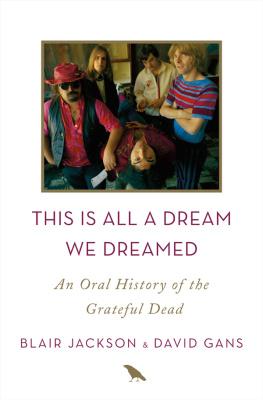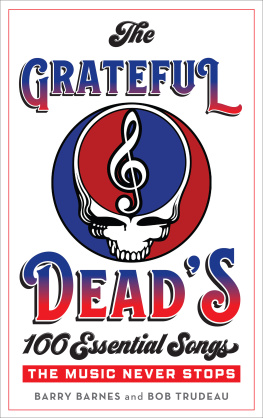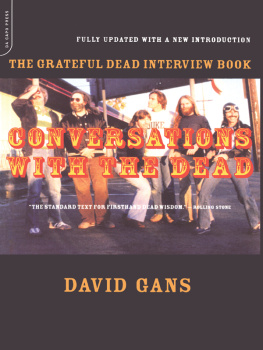Contents
Guide
This Is All a Dream
We Dreamed
An Oral History of the Grateful Dead
Blair Jackson and David Gans

The author and publisher have provided this e-book to you for your personal use only. You may not make this e-book publicly available in any way. Copyright infringement is against the law. If you believe the copy of this e-book you are reading infringes on the authors copyright, please notify the publisher at: http://us.macmillanusa.com/piracy.
This book is dedicated to my brother, Roger, who lit the flame; my wife, Reganmy partner in ecstasy and adventure; and my kids, Kyle and Hayley, who will carry the torch.
Blair Jackson
I dedicate this book to the memory of Alan Feldstein (1952-2009), one of the most knowledgeable, opinionated, and passionate music loversand DeadheadsI ever knew.
We met in 1973, introduced as fellow musicians and fellow heads. The first bootleg Grateful Dead recording I ever heard was from March 23, 1974, at the Cow Palace; Al had it just a couple of weeks after the event. Hearing that tape in his apartment opened up a whole world to me.
Fiddle and I went to many shows together back in the day, and we played music together (our own, the Deads, and more) off and on for more than thirty years. We carried on a deep conversation about this stuff, onstage and online and in person, for decades. Als spirit suffuses this text, because my consciousness as a musician and a Deadhead evolved in concert with his.
David Gans
Please note that some of the links referenced in this work are no longer active.
This book grew out of the wreckage of another book that didnt happen. Stephen Power had a very cool idea, but we werent able to get it all the way into print. The demise of that deal led to a conversation with Bob Miller, the editor of Davids first book and now the head of Flatiron Books. The authors are grateful to Bob for embracing this project with great energy and creativity; thanks also to his colleagues Jasmine Faustino, Karen Horton, David Lott, Marlena Bittner, Steven Boriack, Lisa Goris, Liz Keenan, and Molly Fonseca.
The authors are profoundly thankful to our agent, Sandy Choron, for applying her inspired brand of creativity to every step of this books life, from inception to editing to marketing. Sandy and her husband/partner, Harry Choron, designed and produced the book, too, and we appreciate their openness to our input in that process.
For assistance with exclusive material, we thank Rosie McGee, Howard Rheingold, Stephen Talbot, and Steve Silberman.
We share a deep admiration and respect for the many writers who came before us or were contemporary fellow travelers in chronicling the Grateful Dead world over the past half-century. From Mojo Navigator to Crawdaddy, Rolling Stone to Creem, Circus to Musician, BAM to Guitar Player, Zig-Zag to Duprees Diamond News, the rich tapestry of Grateful Dead history and the surrounding culture has been documented by literally hundreds of journalists, critics, radio and TV folks, and, of course, fans, all sharing glimpses of the Deads inexplicable magic. We have referred to the work of many of them, as we acknowledge in the endnotes and bibliography of this book.
We also want to especially thank these fine (and kind) interviewers for their contributions to our project: Bud Scoppa, Miles Hurwitz, Michael Goodwin, Charlie Haas, Andy Childs, Ann Heppermann and Kara Oehler, Michael Wanger, Charles Reich, and Jann S. Wenner.
Thanks to Molly Brown Strachan, Beth Card, Damien Palermo, Roger Sideman, and Bob Trudeau for help with transcribing. For all-around assistance, were grateful to Barbara Bernstein, Bob Merlis, and Mark Simoncic.
David thanks his wife, Rita Hurault, for endless support, encouragement, and inspiration.
Finally, we acknowledge these vital resources: Corry Arnold, Lost Live Dead (lostlivedead.blogspot.com); Joe Jupille; Nicholas Meriwether, Grateful Dead Archive; David Lemieux, Grateful Dead Productions; the Deadlists Project (deadlists.com); DeadBase (deadbase.com); Grateful Dead Family Discography (deaddisc.com); jerrygarcia.com; Bonnie Simmons; Marty Martinez; and Paul Grushkin.
You got turned on to the Grateful Dead by your older brother, or by a classmate. You were given a concert tape or a vinyl copy of Workingmans Dead or a cassette of Skeletons from the Closet. You were a pothead, probably, and you were or became an acid head (or at least tried it).
You were a member of one or more Deadhead tribes. You went to a Dead show, and then another, and another, and over time you developed connections. You had a group of people you always sat with at the show, and a larger group who would meet somewhere before and after the show. There are people you got tapes from, and people you gave tapes to. You knew people who wore tie-dyed clothing from head to toe, and people who sported high-end Jerry Garcia ties with their four-hundred-dollar suits and recognized other guys doing the same on the subway or at business meetings. Maybe they still do. You had friends and maybe even relatives whose holiday gifts to you tended to be Grateful Deadbranded pint glasses or golf club covers or calendars, dancing bear beanbag dolls, baseball hats, and Grateful Deadrelated books.
Or perhaps none of that applies. You are too young to ever have seen the Grateful Dead, even two decades ago, during the last years. Or you were old enough to have caught the Dead live, but for whatever reason your path just never crossed theirs. You were into other stuff; maybe you even actively disliked them for any number of reasons, but time and exposure have changed your opinion and now you cant get enough. Maybe your exposure to contemporary jam bands led you back in time to the group that started it all.
There are as many routes to the Grateful Dead as there are people who enjoy(ed) them. No membership card was required. There was no acid test to pass, exactly. Getting it on whatever level, wavelength, or intensity you defined made you a Deadhead. You might even have hated that term and all the sociological baggage that came with it: Im a fan, but Im not a Deadhead. That was fine, too. In a way, a line from Dancing in the Streetone of the first cover tunes the Grateful Dead adapted in their early daysperfectly captured the ebullient spirit at the groups core: It doesnt matter what you wear / Just as long as you are there.
The Grateful Dead was about collaboration, spiritual and social democracy, trust, generosity, and fun. It meant a hell of a lot to a hell of a lot of people, and whatever its punk/outlaw/pirate/libertine/bourgeois origins, it became a legitimate American success story by the only standard America understands: money. More important, the Grateful Dead created a unique and eloquent musical language and established a society that sustainedand continues to sustainthe interest and loyalty of millions.
It takes a whole lot of blind men to fully describe an elephant of this size, so we are telling this tale by weaving together stories told by members of the band, their collaborators, their peers, and their fans. The authors are members of this community: each of us was a fan first and then a journalist covering the Grateful Dead world. As such, we helped to shape the culture to some small degree.
David engaged with the Grateful Dead as a musician and strove in his writing to elucidate what was going on musically. Both of us have had the privilege of producing archival recordings and writing liner notes for both Grateful Dead and Jerry Garcia releases. David wandered into the radio business by way of







